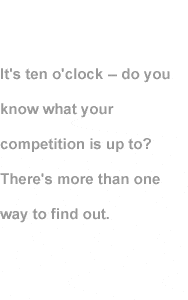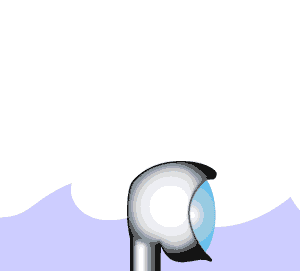 |
|
||||||||||||
 |
|
||||||||||||

|

|
|
By Janice Brand
|
You know they're out there. You see their brochures on your new client's desk; you smile politely at them over watery cocktails at networking parties. In your mind, you can hear them tapping away at their laptops while you've shut down for the night. Fact is, they're probably sending emails and making phone calls to your clients right now. They're the competition -- and you've got to keep up with them. This means knowing what they're up to, what they're charging, who they're getting work from and how. You might even be friendly with some of your competitors, but you've still got to keep tabs on them. Business is business. When Bob Steiner, a restaurant consultant based in Amagansett, N.Y., launched Out East Restaurant Consultants a year ago, he was prepared to face off with some big companies. Steiner planned to address the same kind of restaurant management issues that established corporate competitors had been tackling for years -- hiring, inventory, cost control, and marketing. In order to compete with them, Steiner knew that Out East would have to outperform its competitors in some key areas. To this end, he sought to identify their weaknesses. "When I did my research, I posed as a potential client," Steiner says. "I put all my information together as though I were a customer. At my biggest competitor's Web site, I left an email -- no one got back to me. I called and they told me I had to come to their office in Philadelphia to talk." Diagnosis: poor customer service. "Now someone there could have been having a bad day," says Steiner, "I don't know. But these are the things I thought about when I started consulting." Consequently, Steiner has made it his policy to get back to callers as soon as possible. When it comes to customer service, "time is of the essence," he says. A key part of Steiner's research was finding out what his competitors were charging. He discovered that one charged $500 for the first hour and $300 for every hour thereafter. Steiner couldn't believe it. "If someone's almost bankrupt, how can they afford that?" he says. Yet further research showed that nearly all the competitors' rates were as high. Accordingly, Steiner found he could lure clients by charging half the competitors' rate, and still make a good profit. Because Steiner's tool of choice for researching competitors was the Internet, he became familiar with his competitors' Web sites -- and learned from their shortcomings. He deemed his biggest competitor's site "too busy." "If you go to their site and look at it," he says, "it would take you ten minutes to figure out that they're consultants." By contrast, Steiner made sure that his own site was clean and unambiguous: "Out East: Restaurant Consultants." |
|||||
| ||||||
|
January 3, 2000 Primary Editor: Eric Gershon Illustrator: Lawrence San Production: Keith Gendel |
We'd love to hear your comments about this article! Janice Brand is a freelance writer who lives in Charlestown, MA. If you like, we'd be happy to put you in touch with her, or with any of the other IPs named in this article. | |||||
| ||||||